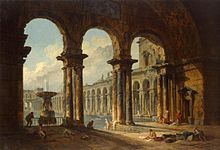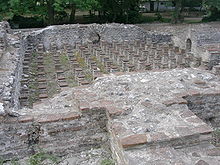- Public bathing
-
 "Ancient Ruins Used as Public Baths" by Hubert Robert (1798)
"Ancient Ruins Used as Public Baths" by Hubert Robert (1798)
Public baths originated from a communal need for cleanliness. The term public may confuse some people, as some types of public baths are restricted depending on membership, gender, religious affiliation, or other reasons. As societies have changed, public baths have been replaced as private bathing facilities became more commonly available. Public baths have also become incorporated into the social system as meeting places. As the title suggests public bathing does not refer only to bathing. In ancient times public bathing included, saunas, massages and relaxation therapies. Members of the society considered it as a place to meet and socialize. It is similar to what we call a spa in today's age.
Contents
Cultures and countries
Further information: History of water supply and sanitationIndus Valley Civilization
The earliest public baths are found in the ruins in of the Indus Valley Civilization. According to John Keay, the "Great Bath" of Mohenjo Daro in present-day Pakistan was the size of 'a modest municipal swimming pool', complete with stairs leading down to the water at each one of its ends.[1] The bath is housed inside a larger—more elaborate—building and was used for public bathing.[1] the Great Bath and the house of the priest suggest that the Indus had a religion.
Greece
In The Book of the Bath, Françoise de Bonneville wrote, "It is unimaginable that bathing would be considered sanitary. In fact it is completely opposite in nature." where men and women washed in basins near places of exercise, physical and intellectual. Later gymnasia had indoor basins set overhead, the open maws of marble lions offering showers, and circular pools with tiers of steps for lounging. Bathing was ritualized, becoming an art – of cleansing sands, hot water, hot air in dark vaulted "vapor baths," a cooling plunge, a rubdown with aromatic oils. Cities all over Ancient Greece honored sites where "young ephebes stood and splashed water over their bodies."
Rome
Main articles: Thermae and Ancient Roman bathingThe first public thermae of 19 BC had a rotunda 25 meters across, circled by small rooms, set in a park with artificial river and pool. By AD 300 the Baths of Diocletian would cover 1.5 million square feet (140,000 m²), its soaring granite and porphyry sheltering 3,000 bathers a day. Roman baths became "something like a cross between an aquacentre and a theme park," with pools, game rooms, gardens, even libraries and theatres. One of the most famous public bath sites is Aquae Sulis in Bath, England.
Dr.Garrett G Fagan, Associate Professor of Classics and Ancient Mediterranean Studies and History at The Pennsylvania State University, has named public bathing as a "social event" for the Romans in his book "Bathing in Public in the Roman World". He also states that "In Western Europe only the Finns still practice a truly public bathing habit." Dr. Fagan has done extensive research on public bathing.[2][3]
Japan
The origin of Japanese bathing is Misogi, ritual purification with water.[4] After Japan imported Buddhist culture, many temples had saunas, which were available for anyone to use for free.
In the Heian period, houses of prominent families, such as the families of court nobles or samurai, had baths. The bath had lost its religious significance and instead became leisure. Misogi became Gyōzui, to bathe in a shallow wooden tub.[5]
In the 17th century, the first European visitors to Japan recorded the habit of daily baths in sexually mixed groups.[4] Before the mid-19th century, when Western influence increased, nude communal bathing for men, women, and children at the local unisex public bath, or sentō, was a daily fact of life.
In contemporary times, many administrative regions require public baths to have separate facilities for males and females. Public baths using water from onsen (hot springs) are particularly popular. Towns with hot springs are destination resorts, which are visited daily by the locals and people from other, neighboring towns.
Ottoman Empire
Main article: Turkish bathDuring the Ottoman Empire public baths were widely used. The baths had both a religious and popular origin deriving from the Qur'an (ablution hitler ritual) and the use of steamrooms by the Turks. The Turkish baths also known as the Hammam, was considered a place for social gathering in Turkish Culture, states the official website Turkish baths. The process of Hammam is very similar to that of the roman bathing.[6]
United Kingdom
Further information: Baths and wash houses in BritainRoman style public baths were reintroduced to England by returning crusaders in the medieval period, who had enjoyed warm baths in the middle east. These, however, rapidly degenerated into brothels or at least the reputation as such. During the reign of Henry II (1154-89) many bath houses were set up on the South bank of the river Thames in Southwark, south of the city of London. They were called bagnios, from the Italian bagno, the word for bath, or "stewhouses" as the clients of the baths stewed in the hot water. By the 12th century there were 18 bagnios in Southwark alone.
Henry VI (1422-61 and 1470-71) closed the bath houses due to their bad reputation as fronts for brothels, but demand for bathing was so great he was forced to reopen them, limiting the number to 12. Finally in 1546, Henry VIII closed them down for good.
In the late 1790s ritual and elite baths were available, but it was not until the mid-19th century that Britain's first true public bath house was opened. These Turkish baths were popularised by the Turkophile MP David Urquhart. The original baths were used for individual washing and men-only swimming. It was not until 1914 that family bathing was allowed.[7]
The introduction of bath houses into British culture was a response to the public's desire for increased sanitary conditions, and by 1915 most towns in Britain had at least one.[8]
United States
In the 19th and 20th centuries, public baths were constructed in the United States, such as Bathhouse Row[9] in Arkansas, and Asser Levy Public Baths in New York City. Public baths were created to improve health and sanitary condition of the public before personal baths became commonplace.
See also
- Bathing
- Steam shower
- By culture
- Gymnasium (ancient Greece)
- Banya – Russian
- Sauna – Finnish
- Hammam – Turkish
- Jjimjilbang & Mogyoktang – Korean
- Sweat lodge - Native American
Notes
- ^ a b Keay, John (2001), India: A History, 13–14, Grove Press, ISBN 0-8021-3797-0.
- ^ http://www.thegreatcourses.com/tgc/professors/professor_detail.aspx?pid=152
- ^ Fagan, Garrett G. "Bathing in Public in the Roman World - Garrett G. Fagan." Google Books. Web. 25 Oct. 2011. <http://books.google.com/books?id=R6tz_TzSVkAC>
- ^ a b Clark 1994, backcover Misogi
- ^ Clark 1994, p.36 Gyōzui
- ^ http://www.aquariussauna.com/turkishbath.htm
- ^ Port Cities: – Liverpool baths and wash houses timeline, 1789–1952
- ^ Profit is a Dirty Word: The Development of Public Baths and Wash-houses in Britain 1847–1915 – SHEARD 13 (1): 63 – Social History of Medicine
- ^ "FORDYCE Bathhouse General History". asms.k12.ar.us. Archived from the original on 2008-02-28. http://web.archive.org/web/20080228001700/http://asms.k12.ar.us/armem/richter/genhisto.htm. Retrieved 2008-03-24.
References
- Clark, Scott (1994). Japan, a view from the bath. University of Hawaii Press. ISBN 0824816579. http://books.google.com/books?id=pT7tP4zFHdYC&printsec=frontcover#v=onepage&q&f=false.
External links
- SaunaScape A directory of public baths worldwide.
- www.OnsenJapan.net Interactive Google map of Japanese baths with easy-to-read icons, pictures, and reviews
- Swiss Indoor and Open-Air Swimming Pool Guide – Directory and Description of Swiss Public Swimming Pools
- SentoGuide – A guide to public baths in Japan
Categories:- Public baths
Wikimedia Foundation. 2010.




